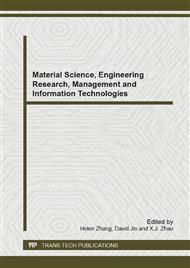[1]
Qiwei Pan, Bingbing Wang, Zhaohui Chen, Jianqing Zhao. Reinforcement and antioxidation effects of antioxidant functionalized silica in styrene–butadiene rubber. Materials & Design, Volume 50, September 2013, Pages 558-565.
DOI: 10.1016/j.matdes.2013.03.050
Google Scholar
[2]
N.Z. Noriman, H. Ismail. The effects of electron beam irradiation on the thermal properties, fatigue life and natural weathering of styrene butadiene rubber/recycled acrylonitrile–butadiene rubber blends. Materials & Design, Volume 32, Issue 6, June 2011, Pages 3336-3346.
DOI: 10.1016/j.matdes.2011.02.020
Google Scholar
[3]
Kaushik Pal, R. Rajasekar, Dong Jin Kang, Zhen Xiu Zhang, Samir K. Pal, Chapal K. Das, Jin Kuk Kim. Effect of fillers on natural rubber/high styrene rubber blends with nano silica: Morphology and wear. Materials & Design, Volume 31, Issue 2, February 2010, Pages 677-686.
DOI: 10.1016/j.matdes.2009.08.014
Google Scholar
[4]
Kaushik Pal, R. Rajasekar, Dong Jin Kang, Zhen Xiu Zhang, Samir K. Pal, Chapal K. Das, Jin Kuk Kim. Influence of carbon blacks on butadiene rubber/high styrene rubber/natural rubber with nanosilica: Morphology and wear. Materials & Design, Volume 31, Issue 3, March 2010, Pages 1156-1164.
DOI: 10.1016/j.matdes.2009.09.037
Google Scholar
[5]
Alexander Ferrauti, Jaime Fernandez-Fernandez, Gaspar Morey Klapsing, Alexander Ulbricht, David Rosenkranz. Diagnostic of footwork characteristics and running speed demands in tennis on different ground surfaces. Sport-Orthopädie-Sport-Traumatologie-Sports Orthopaedics and Traumatology, Volume 29, Issue 3, September 2013, Pages 172-179.
DOI: 10.1016/j.orthtr.2013.07.017
Google Scholar
[6]
Lisa Ferrara, Anders Cohen. A Mechanical Study on Tennis Racquets to Investigate Design Factors that Contribute to Reduced Stress and Improved Vibrational Dampening. Procedia Engineering, Volume 60, 2013, Pages 397-402.
DOI: 10.1016/j.proeng.2013.07.015
Google Scholar
[7]
Juan Liu, Hongling Yi, Heng Lin, Baicun Zheng. Tennis core strings of polyamide-6 modified by surface-capped nano-silica. Applied Surface Science, Volume 265, 15 January 2013, Pages 704-708.
DOI: 10.1016/j.apsusc.2012.11.088
Google Scholar
[8]
Markus Raab, Rich S.W. Masters, Jonathan P. Maxwell. Improving the how' and 'what, decisions of elite table tennis players. Human Movement Science, Volume 24, Issue 3, June 2005, Pages 326-344.
DOI: 10.1016/j.humov.2005.06.004
Google Scholar


